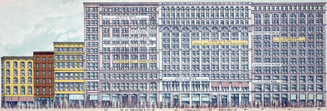
Broadway in the 19th Century
After the 1760s, the section of present Broadway, north of Vesey Street, was officially called the Great George Street, but it was not a popular name. In 1794, it was officially renamed Broadway.
By 1811, Broadway ended at 10th Street, where it merged with the Bloomingdale Road. By 1865, the section below 59th Street was called Broadway.
In the early 19th century the area which became Union Square was an intersection of roads, the Bloomingdale (later Broadway) and the Bowery (later Forth Avenue), with farms and old dwellings around. It was then known as "the Forks". The "Union Place" was projected under the Commissioners’ Plan of 1811, originally extended from 1oth Street to 17th Street. The present size of Union Square, from East 14th Street, on the south, to East 17th Street on the north, was established in 1832 by an act of the legislature. It became the Union Park by 1839 and by the late 1840s, the area surrounding the Union Park was already a well developed residential place. Throughout the second half of the 19th century, several commercial structures replaced the residential buildings at the Union Square.
From City Hal Park, at Chambers St, to Union Sq. at 14th St.
More pages about Broadway:
• Broadway in the 19th Century ►
• Lower Broadway ►
• Lower Broadway in the First Half of 19th Century ►
• Lower Broadway in the Second Half of 19th Century ►
• Lower Broadway in the First Half of 20th Century ►
• West Side, Morris to Rector Streets - 19th Century ►
• West Side, Morris to Rector Streets - 20th Century ►
• Broadway at Park Row Intersection ►
• Broadway at City Hall Park ►
Broadway from East 10th Street.

Broadway, east side. Prince to Houston streets, 1899, with the buildings erected on the site of the old Metropolitan Hotel.
Broadway in the 19th Century

Broadway, west side, from 10th to 12th Street in 1899. The St. Denis Hotel is represented in the southwest corner of 11th Street.
|
Copyright © Geographic Guide - Antique photographs of NYC, 19th Century. |
